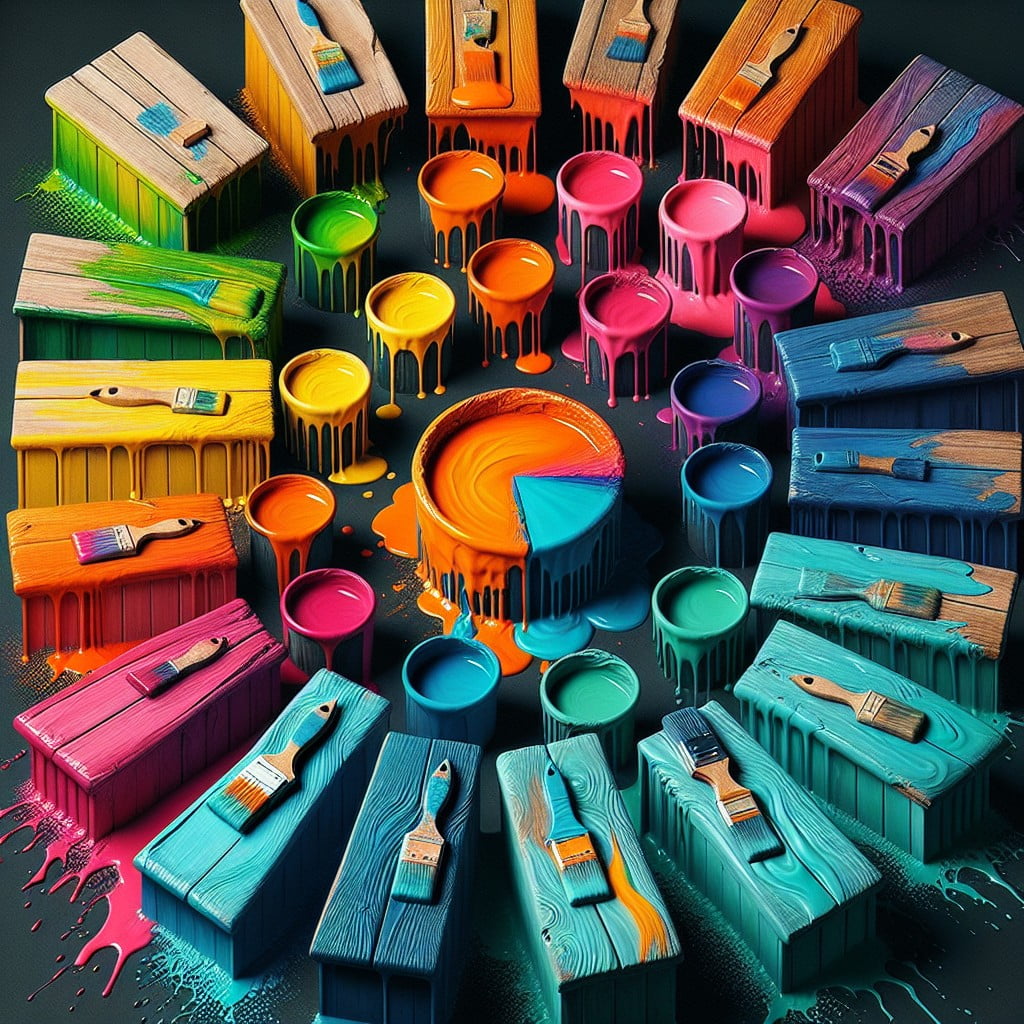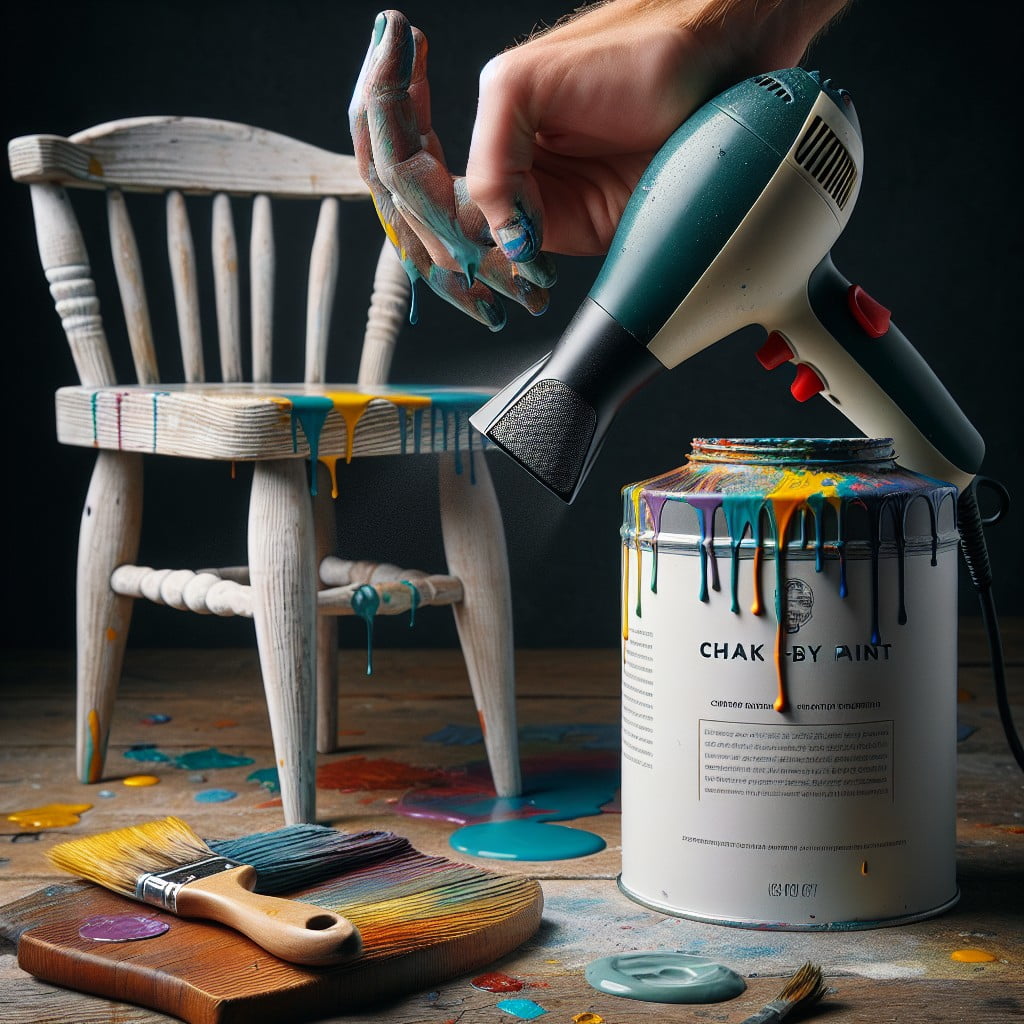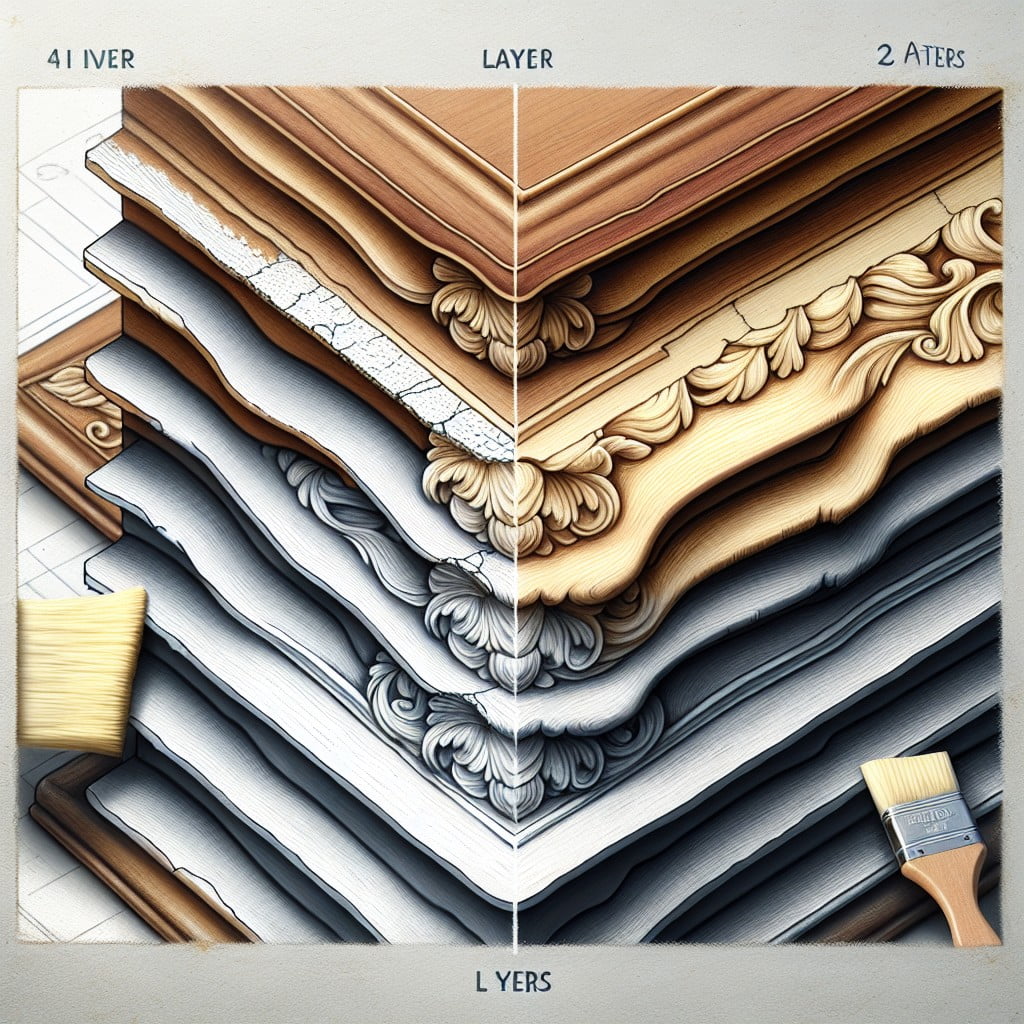Last updated on
In this comprehensive guide, you’ll unlock the secret to understanding exactly how long it takes for chalk paint to dry, enabling you to handle your future painting projects like a pro.
Key takeaways:
- Chalk paint dries to the touch within 15 to 30 minutes.
- Full drying, ready for another coat or distressing, takes about 24 hours.
- Factors affecting drying time include humidity, temperature, ventilation, and paint thickness.
- To speed up drying, enhance air circulation, use thin coats, and choose a warm environment.
- Chalk paint typically cures fully in 2 to 3 weeks.
Factors Affecting Chalk Paint Drying Time

Humidity plays a crucial role in the drying process; high humidity levels can significantly increase drying time. On the contrary, low humidity can make chalk paint dry faster. Temperature also has a noteworthy impact. Optimal drying occurs at room temperature, around 70°F (21°C). Cooler temperatures slow down the drying, while extreme heat can cause the paint to dry unevenly or crack.
Ventilation should not be overlooked. Good airflow helps to evaporate solvents from the paint, speeding up drying. However, too much airflow, like a fan set on high right next to the painting surface, might cause unwanted texturing or dust collection.
The thickness of application affects drying times as well. Thinner coats dry quicker than thicker ones, making it advisable to apply multiple light coats rather than one heavy one. Additionally, the paint absorbs at different rates depending on the surface being painted. Porous materials like raw wood will absorb and dry faster compared to non-porous surfaces like metal or plastic.
Lastly, the paint brand and its specific formula can impact drying time; some brands or types are designed to dry more quickly than others. Always check manufacturer recommendations for the ideal drying conditions for the specific product you’re using.
Typical Drying Time for Chalk Paint

On average, chalk paint dries to the touch within 15 to 30 minutes. This quick drying time is one of the reasons chalk paint is favored for home projects and furniture revamps.
Full drying, which is the point at which the paint has settled and hardened sufficiently to add another coat or to distress the surface, typically occurs in about 24 hours. However, these times can vary based on a few variables such as paint thickness, environmental conditions, and the surface it’s applied to.
Thin layers will generally dry faster than thick ones, and a low humidity, warm environment promotes quicker drying compared to a cooler, more humid atmosphere. It’s important to follow manufacturer’s instructions too, as drying times can differ slightly between brands.
Accelerating the Drying Process

If you’re eager to speed up the drying process for chalk paint, consider the following tips:
1. Enhance Air Circulation: Increase airflow by opening windows or using fans. This removes moist air around your piece and brings in dry air, hastening drying.
2. Use Thin Coats: Apply chalk paint in thin, even layers. Thicker coats take longer to dry, while thinner layers dry more quickly and evenly.
3. Opt for a Warm Environment: Warmth can expedite the drying process. Ensure the room is at a comfortable warm temperature without being too hot, which can cause the paint to crack.
4. Avoid Humidity: Paint in a low-humidity environment. Damp air slows drying time, so choose a day with low humidity if possible.
5. Employ a Hair Dryer or Heat Gun: For small projects, gently apply warm air from a hair dryer or heat gun, keeping it at a safe distance to prevent the paint from blistering.
6. Utilize Natural Sunlight: Direct sunlight naturally warms and dries painted surfaces. If feasible, place your painted item outdoors or near a sunny window.
By implementing these strategies, you’ll find that your chalk paint project will be dry to the touch more quickly, allowing you to move on to the next steps in less time.
How Long Should It Dry Before a Second Coat

The ideal waiting time between applying the first and second coat of chalk paint typically ranges from 1 to 2 hours. Ensure the first layer feels dry to the touch before proceeding with the next. If you’re working in a humid environment or the layer applied was thick, it’s wise to extend this waiting period to eliminate any risk of the paint not adhering properly or the finish becoming uneven.
For the best results, always check the manufacturer’s recommendations as drying times can vary slightly between brands. Remember to touch the paint lightly with your fingertips; if it no longer feels tacky, it’s ready for another coat. Avoid sanding between coats unless looking for a distressed finish or the need to smooth out imperfections.
Conditions That Extend Drying Time
When your chalk paint is taking its sweet time to dry, consider the environment it’s in. High humidity acts like a slow-moving fog, clutching onto the paint and preventing it from drying swiftly. If it’s particularly damp or raining outside, expect a longer wait. Cold temperatures are equally leisurely; they chill the drying process to a crawl, so always aim for the paint’s sweet spot: a warm, dry day.
The airflow, or lack thereof, can also hinder drying. A room with stagnant air is like a crowded dance floor where moisture struggles to move. Introduce some rhythm with a fan to get air circulating, but be mindful of dust that could tango with your fresh coat.
Thick layers are the lavish gowns of the paint world: beautiful but burdensome. They take an age to dry. Aim for thin, even coats, which are the casual wear of the paint world—drying quickly and efficiently.
Lastly, the surface itself plays a role. Non-porous materials may hold onto the moisture in the paint, not unlike a sponge, requiring more time for the paint to release that moisture and set. Consider the material you’re working with and adjust your expectations accordingly.
How Long Should Chalk Paint Dry Before Adding a Topcoat
Before applying a topcoat or wax to your freshly painted surface, it’s crucial that the chalk paint is completely dry. This typically means waiting about 24 hours after the final coat of chalk paint. While it might feel dry to the touch much sooner, waiting ensures that the paint has set to avoid any potential mixing or smearing when applying the topcoat.
Ambient conditions play a role in this waiting period; high humidity or cool temperatures could necessitate a longer dry time. It’s always better to err on the side of caution and allow for extra drying time in such environments.
Before you begin with the topcoat application, gently run your hand over the painted surface. It should feel completely smooth and dry, without any tackiness. If there is any doubt about the readiness of the paint, giving it a few more hours will prevent problems like streaking or an uneven finish. Remember, patience at this stage will contribute notably to the final quality and durability of your painted piece.
Testing for Dryness
Determining if your chalk paint is ready for the next step involves a simple touch test. Gently press a finger against the surface. If the paint feels solid and leaves no residue, it’s dry. However, be cautious not to press too hard as the paint might still be delicate.
For those less inclined to use the touch method, observe the color. Chalk paint tends to darken slightly when fully dry. Keep in mind that even if the coat feels dry to the touch, curing for a longer time may be necessary before applying a topcoat or heavy use to ensure durability and the best finish.
Chalk Paint Cure Time
Understanding the distinction between drying and curing is crucial when working with chalk paint. While the former refers to the paint feeling dry to the touch, the latter involves the paint fully hardening and reaching its maximum durability. Typically, chalk paint requires about 2 to 3 weeks to fully cure. During this time, the paint undergoes a chemical process that solidifies the bond to the surface it’s been applied to.
To ensure the best results:
- Avoid placing heavy objects on the painted surface until the paint has completely cured to prevent dents or scratches.
- Keep the temperature and humidity levels consistent in the room where the freshly painted item is located, as fluctuating conditions can hinder the curing process.
- Refrain from aggressive cleaning or wiping of the surface, which can disrupt the curing paint; use gentle cleaning methods if necessary.
By allowing adequate cure time, you ensure that the painted surface gains full strength for everyday use, preserving both the aesthetic and the longevity of the finish.
Troubleshooting Tacky or Slow-Drying Chalk Paint
If your chalk paint remains tacky or seems to be drying slowly, several factors could be at play. Humidity is a common culprit; high moisture levels in the air can extend drying times significantly. Ensure adequate ventilation to promote air circulation and consider using a dehumidifier in highly humid climates.
The thickness of the application can also affect drying time. Thin, even coats are best for speedy drying, whereas thick coats may remain sticky. If overapplication is the issue, gently sand the tacky surface with fine-grit sandpaper, remove the dust, and apply a thinner layer.
Consider the surface you’re painting on as well. Certain finishes or materials may require a primer to prevent the paint from being absorbed too quickly or not adhering properly.
Lastly, review the manufacturer’s instructions. Some paints may have specific conditions or additives that alter drying times. If instructions have been followed closely and tackiness persists, contact the manufacturer for advice; there may be a problem with the paint batch itself.
Maintaining Chalk Paint After Drying
Maintaining your newly dried chalk painted surface ensures its longevity and beauty. Here are some best practices:
- Use a Soft Cloth: Wipe with a gentle, dry cloth to remove dust without scratching the surface. For more persistent marks, slightly dampen the cloth with water.
- Apply Wax or Sealer: Consider applying a layer of wax or sealer to protect the paint. This is especially useful for items that will see a lot of use, like furniture.
- Keep It Cool: Store or position chalk-painted items away from direct sunlight and heat sources, which can cause fading or softening of the wax layer.
- Avoid Harsh Chemicals: Clean the surface using mild, non-abrasive cleaners to prevent damage to the finish.
- Touch-Up If Necessary: If you notice some wear or chips, simply touch up with the same paint. Quick correction avoids more extensive repairs later.
- Regular Checks: Periodically check for any signs of wear or damage to address straight away.
By following these points, your chalk-painted surfaces will retain their charming matte finish and stand the test of time.
Final Thoughts
Once your chalk paint masterpiece reaches the desirable level of dryness and has fully cured, it’s primed for showcasing or everyday use. This process, while requiring a bit of patience, rewards you with a durable and unique finish.
Remember that the ambient temperature and humidity play pivotal roles in drying time, so adjust your project timeline accordingly. Keeping your freshly painted item in a well-ventilated area ensures optimal drying conditions.
If you encounter any issues, such as tackiness or an uneven finish, don’t hesitate to revisit the painting instructions or reach out to the paint manufacturer for guidance.
Regular maintenance, including gentle cleansing and careful handling, will prolong the life and appearance of your chalk-painted item.
Happy painting!
FAQ
How long should chalk paint dry before using?
Chalk paint should typically be allowed to dry for a full 24 hours between coats to ensure adequate drying time and optimal product performance.
How many coats of chalk paint do you need?
Typically, one to two coats of chalk paint are sufficient for most surfaces without requiring any prior sanding or priming.
What happens if you don’t wax chalk paint?
If chalk paint is not waxed, it is prone to marking and water damage, and it can be easily scratched or otherwise compromised.
Is it necessary to sand between coats of chalk paint?
No, it’s not necessary to sand between coats of chalk paint.
Can chalk paint be applied directly on varnished wood?
Yes, chalk paint can be applied directly on varnished wood without the need for priming or sanding.
What are the possible downsides to not letting chalk paint dry adequately before waxing?
Failing to allow chalk paint to dry adequately before waxing can result in a streaky finish, uneven color, and potentially cause the wax to not adhere properly.
Recap:




